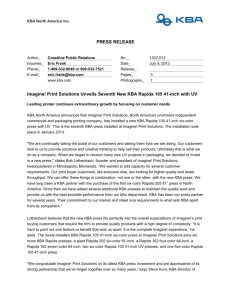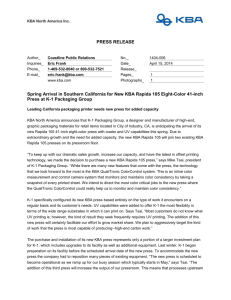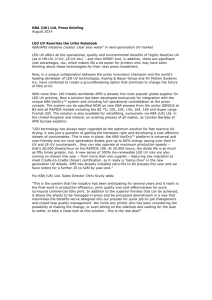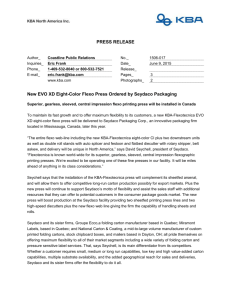KBA Shave and Gibson RAPIDA 145
advertisement
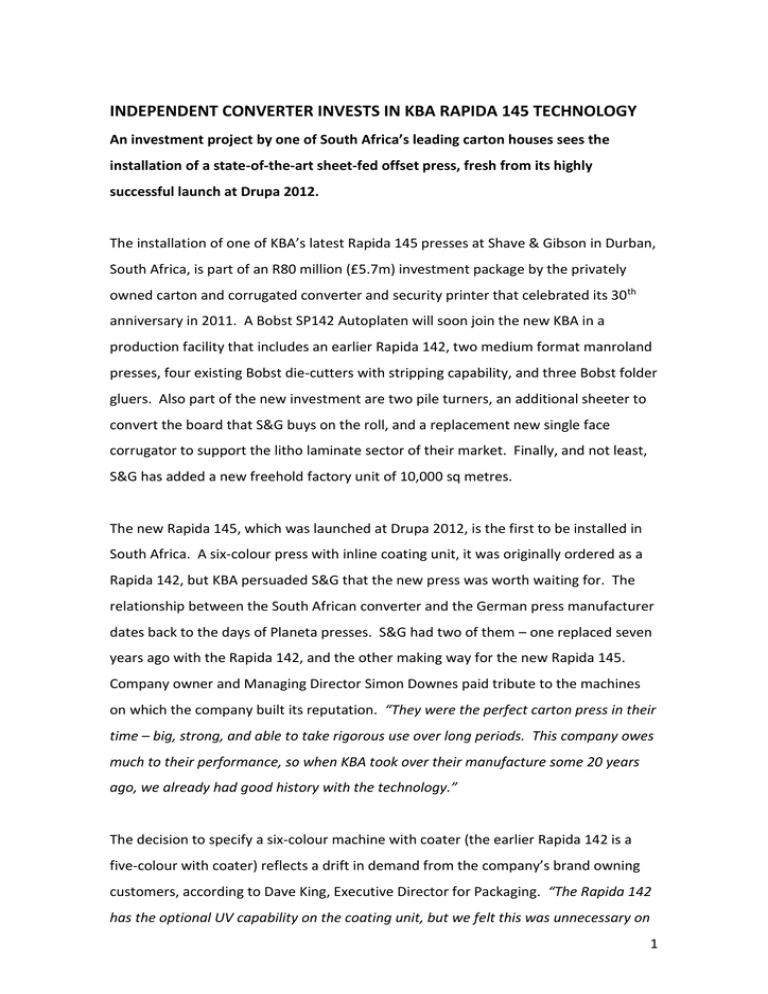
INDEPENDENT CONVERTER INVESTS IN KBA RAPIDA 145 TECHNOLOGY An investment project by one of South Africa’s leading carton houses sees the installation of a state-of-the-art sheet-fed offset press, fresh from its highly successful launch at Drupa 2012. The installation of one of KBA’s latest Rapida 145 presses at Shave & Gibson in Durban, South Africa, is part of an R80 million (£5.7m) investment package by the privately owned carton and corrugated converter and security printer that celebrated its 30 th anniversary in 2011. A Bobst SP142 Autoplaten will soon join the new KBA in a production facility that includes an earlier Rapida 142, two medium format manroland presses, four existing Bobst die-cutters with stripping capability, and three Bobst folder gluers. Also part of the new investment are two pile turners, an additional sheeter to convert the board that S&G buys on the roll, and a replacement new single face corrugator to support the litho laminate sector of their market. Finally, and not least, S&G has added a new freehold factory unit of 10,000 sq metres. The new Rapida 145, which was launched at Drupa 2012, is the first to be installed in South Africa. A six-colour press with inline coating unit, it was originally ordered as a Rapida 142, but KBA persuaded S&G that the new press was worth waiting for. The relationship between the South African converter and the German press manufacturer dates back to the days of Planeta presses. S&G had two of them – one replaced seven years ago with the Rapida 142, and the other making way for the new Rapida 145. Company owner and Managing Director Simon Downes paid tribute to the machines on which the company built its reputation. “They were the perfect carton press in their time – big, strong, and able to take rigorous use over long periods. This company owes much to their performance, so when KBA took over their manufacture some 20 years ago, we already had good history with the technology.” The decision to specify a six-colour machine with coater (the earlier Rapida 142 is a five-colour with coater) reflects a drift in demand from the company’s brand owning customers, according to Dave King, Executive Director for Packaging. “The Rapida 142 has the optional UV capability on the coating unit, but we felt this was unnecessary on 1 the new 145. There is, however, a general trend from five colours to six, and we value the promised faster make-ready and changeover capability of the new press even though it will be used predominantly for our long run work,” he said. Typical run lengths on the large format presses is 18,000 to 20,000 sheets, with the medium formats averaging around 11,000 sheets. This mix fits well with S&G’s work, which ranges from very small format cartons to large sizes that are run off one-up on a sheet. S&G’s operators were immediately impressed with the increased user-friendliness and improved accessibility for service and maintenance on the new 145, as well as its faster production speed, which is proving valuable on the longer run work for which the 145 is intended, adding capacity and shortening lead times. Specification of the new Rapida 145 includes six print units, with fully automatic plate changing, plus a coating unit, and a 2.6 metre extended delivery fitted with the KBAVariDry IR/hot air system. The inking units are temperature controlled with Technotrans air-cooled duct rollers, and the press has CleanTronic, which is a multi purpose system for the simultaneous washing of blankets and impression cylinders. The delivery is fitted with EES (Emission Extraction System), and colour is controlled by KBA’s ErgoTronic system, with overall press control by LogoTronic, which features a workstation with CIPLink X-system for CIP3 working. Capable of handling sheets from 500 x 600 mm up to 1060 x 1450 mm, the Rapida 145 has a maximum print format of 1050 x 1450 mm, and will handle paper stock and board up to 450 gm or 1.2 mm thick. Both impression and transfer cylinders are of double diameter to facilitate the sheet path of thicker material, and in classic carton tradition, the cylinders are arranged in the 7 o’clock configuration so that printing is complete before sheet transfer takes place. Work at S&G is largely for the ‘fmcg’ market, with food and household goods high on the list. Other markets supplied include white goods, and more recently wine boxes for a number of the South African growers who export their product to Europe. “The design graphics on some of these wine boxes are interesting. They include a number of 2 added value techniques like combining matt and gloss varnish, spot UV varnishing and spot foiling, and are indicative of the styles required in Europe, but not seen here,” commented Dave King. “Because traditionally bag-in-box wine is seen as a low cost product in South Africa, these finishes have not yet filtered through to local designs. However, it is only a matter of time before design agencies see their worth in terms of packaging impact” he added. With international brand-owning customers like Nestlé, KFC, and Unilever to serve, as well as many local manufacturers, S&G is working towards IS0 2000 accreditation for food safety to further consolidate the various customer specific programmes for which it is already recognised – no easy task in an older factory, but according to King: “More of an audited extension of our existing policy than a major change in housekeeping.” The company became an acknowledged FSC supplier this year, which King claims was largely driven by brand owner pressure, but he admits it’s a useful badge to wear. When Simon Downes acquired the company in 2005 (he was formerly Financial Director), he inherited a well-established business created by Neville Shave and Alan Gibson. Over the past seven years he has built it to become one of the country’s leading independent companies, and has plans to extend its capabilities. “The latest tranche of investment is designed to increase capacity and productivity, and allow us to cut our lead times while also reducing our shift pattern. The investment climate in Durban is not positive right now, and the Rand is weakening on the currency market, but we see this situation as a prime opportunity to expand and steal a march on our competitors. I’ve always maintained that running a successful business is not about price – it’s about cost,” he concluded. /ends 3
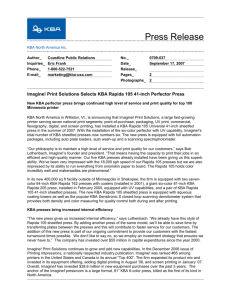
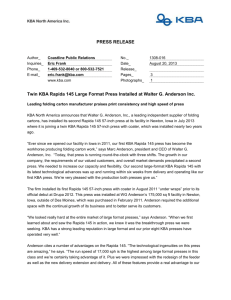
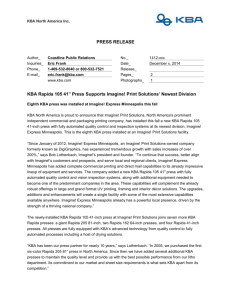
![[#CUI-132] Refactor KBA logic in the self](http://s3.studylib.net/store/data/007693991_2-1f0c6d35c466219f4ae45a2cfc57ed98-300x300.png)
